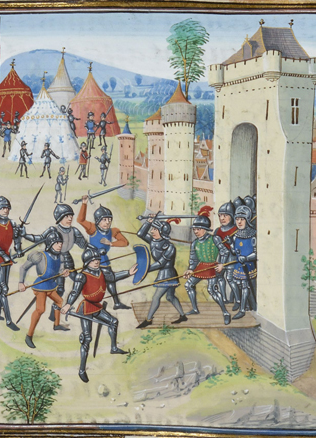Means of Travel and Transportation
The image of Lithuania as a land of impenetrable forests and deadly marshes often emerges in the 13th and 14th century historiography that describes the country. Sources indicate that natural obstacles and secret paths, some of them underwater, known only to local people were important as the means of protection against Christian aggressors. At the dawn of statehood, the tribes of the Balts were separated by large areas of wilderness referred to in the 14th century descriptions of the Crusader war raids in Lithuania, or Wegeberichte, such as lands less suitable for agriculture, swamps or territories covered with forest. In the middle of the 13th century, during the years of Mindaugas’ rule when the Lithuanian state was taking shape in the lands inhabited by Balts and neighbouring Slavs, the demand for fast – within the limits of the period – domestic and international travel increased considerably. It is difficult to think of international communication, be it peaceful or warlike, without roads and means of transport that can use them. The mobility of the aristocracy in the 13th and 14th century is a characteristic feature of the epoch. Due to vast geographical expanses occupied by the Grand Duchy of Lithuania, a dukes and their military chiefs would spend a substantial part of their lives “on the road”. As a term, the road in this case means more than just land roads suitable for waking, riding or driving because rivers and lakes, used for shipping in summertime, would turn into excellent ice “trunk roads” in winter.
What do we learn from the crusader “tour guides around Lithuania”?
Historical sources illustrate the roads of the time. The 14th century Wegeberichte are particularly informative. They are not, however, road maps of the period. The historical descriptions merely indicate possible directions for war raids and routes leading to particular locations as well as tasks the war-heroes-to-be should prepare for, including tree cutting, making way through swamps, building bridges, removal of various barriers and the like. A new road, an old road, a good road, a thoroughfare, and a road for the military – these are the descriptions of roads in Lithuania that the historical documents provide. This serves as a proof that there was an infrastructure of roads in the country used for domestic communication. Regular maintenance of roads was among local people’s duties before the Grand Duke. “Old” roads can be linked to trade relations, but the main trade routes, such as the Daugava River, the upper reaches of the Nemunas, and the Baltic Sea, were on the periphery of the early GDL. The road made free for trade, or fredeweg, which ran from Ragainė to Medininkai and Kaltinėnai in the “impenetrable” Samogitia of the 14th century, features the list of roads compiled by Crusaders. Several 14th century treaties between the states, which aimed at securing international trade, also mention roads. The treaty signed by the supporters of Gediminas and the Livonian Order and the citizens of Riga singled out special territories for trade roads by banning military activity there. The text of the treaty says: “Further on, roads on both sides of Daugava, below the mouth of Aiviekste, must be safe to every merchant as far as he can throw a spear. A merchant can travel further on undisturbed by that road, called a free road.”
Trade routes stretching along larger rivers was a common occurrence these days.
Bridges were scarce. Samogitians would not build bridges at all in order to protect themselves against surprise attacks of the Crusaders. Crusader chronicles mention a bridge across the Neris River burnt down during the raid in 1365 while in 1369 the German knights found the bridge, which they described with the word “mean”, across the Nemunas beside the Castle of Paštuva. There is historical information, however, witnessing the ability of the Lithuanian warriors to build temporary bridges during their military raids.
Horses were the most widespread means of transportation of the time. Horses would help people travel longer distances and transport goods. Horses would also ensure quick travel. Swift offensives and even swifter pullbacks were among essential elements of the military tactic employed by all parties involved in wars. Findings in horse graves, hundreds of which have been explored by archaeologists, also attest the importance of horses. A number of attributes of horses and riders, including spurs, bits, stirrups, bridles and other details of horse “attire”, have been unearthed in cultural layers of the 13th and 14th centuries. Archaeologists have not found a single horseshoe from that period though. That means horses would not risk wearing down their hooves on roads simply because they were not stone-paved in the 13th and 14th centuries. On the other hand, archaeologists found several iron thorns, to be nailed into hooves, in Kernavė. The thorns were used to prevent horses from slithering on ice.
Roads of ice and water
In winter time, frozen lakes and rivers would significantly expand the network of land roads. As temperatures dropped in the 13th century, winters became extremely cold. All inland waters would be covered with ice in winter months and, occasionally, even the Baltic Sea which was completely frozen at least ten times. In his Livonian Chronicle, Henry of Latvia mentions Lithuanians who marched on the ice of the frozen Daugava River in the winter of 1201–1202 against Semigallians until they reached the mouth of the river. It is likely that there were more raids of that kind when warriors used frozen rivers as roads. According to historical sources, Lithuanians ran into the joint German and Danish army on the ice-covered Baltic Sea on their way back from a raid in the island of Saaremaa in the winter of 1219–1220. As the knights attacked, Lithuanians retreated behind barriers made of sledges and killed all horses of the knights entangled in the sledges and then started a long slaughter that ended in victory.
Thus, Lithuanians used horse-pulled sledges as the means of transport in winter back in the early 13th century.
Archaeological findings in Vitebsk, a city of the GDL for several centuries, feature plenty of sledge details, especially parts of runners. Artisans usually used hardwood, including oak, alder and elm, to produce runners. Medieval sledges from Vitebsk are not much different from those used in the 19th century. Sledges were popular in the old Rus’ for a long time. They were considered more valuable than the wheeled means of transport even in the 17th century. People living in wet lands of Rus’ used sledges even in summer time. Historical information on wheeled means of transport, such as carts, in the 13th and 14th centuries is scarce. Scientists unearthed a fairly well-preserved 164-centimetre-long eight-spoke wooden wheel in the territory of the Lower Castle in Vilnius. Historians maintain the wheel was in use in the second half of the 14th century. Archaeologists have also found wooden spokes of cart wheels in Minsk, Brest, Polotsk and other former cities of the GDL. There are also indirect evidences that horse-pulled means of transport – carts and sledges – were used in the 13th and 14th century. The exploration of ancient streets between homesteads in Vilnius and Kernavė revealed they were up to four metres wide, indicating they could have been used not only by pedestrians.
Historians possess vague information depicting water transport and likely shipping in the 13th and 14th century Lithuania. Curonians, whose ships would crisscross the Baltic Sea and would drive residents of the island of Gotland into panic, had already been gone into oblivion. The German Order controlled the seashore inhabited by the Balts almost entirely. Lithuanians were rare guests, and often unwelcome, by the Daugava River, the important trade route at the time. The means of water transport produced by Lithuanians at the time, most likely, were no really different from those made in the stone age. They included dugouts and rafts, the latter mostly used in rivers. According to Hermann von Wartberge, select Lithuanian warriors were smart enough to make themselves a number of small boats using tree bark during a military raid in 1375. They then reached the intended location, hid the boats and stormed the surroundings of Rozite. They certainly used simple boats, unsuitable for long merchant or military travel that normally ends with a return to the port of departure.
Gintautas Vėlius



